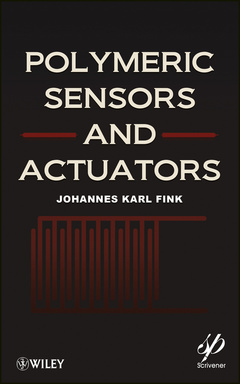Polymeric Sensors and Actuators Polymer Science and Plastics Engineering Series
Auteur : Fink Johannes Karl

The book exhaustively covers the various polymers that are used for sensors and actuators from the perspective of organic chemistry.
The field of polymeric sensors and actuators is developing very rapidly as newly derived polymer materials are suitable for sensor technology. This book uniquely and comprehensively covers the various polymers that are used for sensors and actuators. The author has researched both scientific papers and patents to include all the recent discoveries and applications. Since many chemists may not be very familiar with the physical background as well as how sensors operate, Polymeric Sensors and Actuators includes a general chapter dealing with the overall physics and basic principles of sensors. Complementary chapters on their methods of fabrication as well as the processing of data are included. The actuators sections examine the fields of applications, special designs, and materials. The final chapter is dedicated to liquid crystal displays. The book concludes with four extensive indices including one special one on analytes to allow the practitioner to easily use the text.
This comprehensive text examines the following sensor types:
- Humidity Sensors
- Biosensors
- Mechanical Sensors
- Optical Sensors
- Surface Plasmon Resonance
- Test Strips
- Microelectromechanical (MEMS) Sensors
- Piezoelectric Sensors
- Acoustic Wave Sensors
- Electronic Nose
- Switchable Polymers
Preface v
1. Sensor Types and Polymers 1
1.1 Sensor Types 2
1.2 Basic Polymer Types 19
2. Methods of Fabrication 41
2.1 Patterning Techniques 41
2.2 Coating Techniques 41
2 3 Electrospinning 46
2.4 Molecular Imprinted Polymers 48
2.5 Sensor Arrays 50
2.6 Ink J et Fabrication 57
3. Processing of Data 67
3.1 Evaluation of Multivariate Data 67
3.2 Response of a Sensor Array 68
3.3 Least Square Method 69
3.4 Linear Solvation Energy Relationships 70
3.5 Euclidean Fuzzy Similarity 71
3.6 Adaptive Resonance Theory 71
3.7 Modelling of Sensors 72
3.8 Bioinspired Models for Pattern Recognition 74
4. Humidity Sensors 77
4.1 Calibration 78
4.2 Capacitive Humidity Sensors 78
4.3 Resistance Type Humidity Sensors 81
4.4 Bragg Grating Sensor 87
4.5 Fiber Optic Sensor 92
4.6 Surface Acoustic Wave Based Sensors 92
4.7 Microwave Oven Humidity Sensors 96
5. Biosensors 101
5.1 Waveguide Sensors 102
5.2 Active Elements 104
5.3 Special Examples 107
6. Mechanical Sensors 129
6.1 Bending Sensors 129
6.2 Cantilever Type Sensors 130
6.3 Micromechanical Oscillators 130
6.4 Microelectromechanical Capacitor Array 132
6.5 Change in Thermodynamic Properties 132
6.6 Dielectric Elastomer Sensors 132
6.7 Polymers for Mechanical Sensors 133
6.8 Cardiac Infarction Monitoring 135
7. Optical Sensors 139
7.1 Conjugated Polymers 139
7.2 Amplified Fluorescent Polymers 145
7.3 Nanostructured Materials 160
7.4 Micelle-Induced Fluorescent Sensors 164
7.5 Fiber Sensors 164
7.6 Waveguides 167
7.7 Chiral Sensors 168
7.8 Molecularly Imprinted Polymers 168
7.9 Glucose Sensors 172
7.10 Hydrophilic Polymer Matrices 180
7.11 Special Analytes 181
7.12 pH Sensors 207
8. Surface Plasmon Resonance 225
8.1 Application as Sensors 225
8.2 Basic Principle 226
8.3 Theory 226
8.4 Waveguide Surface Plasmon Resonance 229
8.5 Nanoparticles 230
8.6 Surface Plasmon Resonance with Fibers 234
8.7 Combinations with other Principles 235
8.8 Examples for Use 235
9. Test Strips 241
9.1 Cations 241
9.2 Anions 243
9.3 Organic Analytes 246
9.4 Immunochromatographic Tests 254
9.5 Bacteria 260
10. Electrochemical Sensors
10.1 Basic Principles 269
10.2 Carbon Nanotube Field Effect Transistors 276
10.3 Chemical Resistors 277
10.4 Temperature Sensors 282
10.5 Smart Textiles 285
10.6 Molecularly Imprinted Polymers 287
10.7 Other Analytes 298
11. Piezoelectric Sensors 317
11.1 Theoretical Aspects 317
11.2 Automotive Applications 318
11.3 Paint Sensors 319
11.4 Molecular Imprinted Polymers 320
11.5 Food Safety Applications 322
11.6 Gases 323
11.7 Tactile Sensors 325
12. Acoustic Wave Sensors 331
12.1 Analytes 331
13. Electronic Nose 343
13.1 Methods for Validation 343
13.2 Medical Applications 349
13.3 Fire Detectors 355
13.4 Pipeline Inspection 356
13.5 Sensing Arrays with Colloidal Particles 357
13.6 Nanodisk Sensor Arrays 358
13.7 Food Testing 360
13.8 Soil Volatile Fingerprints 365
14. Switchable Polymers 369
14.1 Shape-memory Polymers 370
14.2 Chemical Switches 371
14.3 pH Sensitive Switches 384
14.4 Photo Responsive Switches 390
14.5 Molecular Gates 393
14.6 Thermofluorescence Memories 396
14.7 Electric and Magnetic Switches 398
14.8 Switchable Wettability 400
14.9 Multiple Responsive Switches 402
14.10 Environmental Uses 404
15. Actuators 415
15.1 Mathematical Model 417
15.2 Fields of Application and Special Designs 419
5.3 Materials 426
15.4 Carbon Based Conductive Materials 447
15.5 Medical Applications 452
15.6 Optical Applications 454
15.7 Pumping Applications 456
16. Liquid Crystal Displays 467
16.1 Basic Design 467
16.2 Polymers 471
16.3 Special Display Types 477
16.4 Viewing Helps 479
References 483
Index 487
Acronyms 487
Chemicals 490
Analytes 501
General Index 504
Johannes Karl Fink is a professor of macromolecular chemistry at Montanuniversität, Loeben, Austria. His industry and academic career spans more than thirty years in the fields of polymers, and his research interests include characterization, flame retardancy, thermodynamics and degradation of polymers, pyrolysis, and adhesives. Professor Fink has published several books on physical chemistry and polymer science including A Concise Introduction to Additives for Thermoplastic Polymers (Wiley/Scrivener) and Handbook of Engineering and Specialty Thermoplastics (Wiley/Scrivener).
Date de parution : 10-2012
Ouvrage de 536 p.
16.3x24.4 cm
Thème de Polymeric Sensors and Actuators :
Mots-clés :
polymers; polymers used in sensors; types of polymers used in sensors; physics of sensors; principles of sensors; sensor operation; fabrication of sensors; smart textiles; actuators; humidity sensors; temperature sensors; chemical sensors; mechanical sensors; optical sensors; electrode sensors; electronic noise sensors; biosensors



